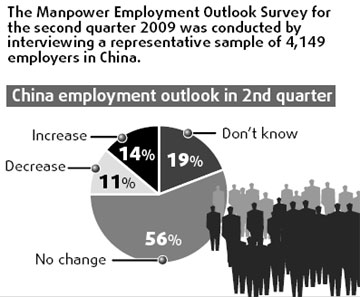
When university graduate Lu Lin accepted her first job offer yesterday from a public relations company in Chengdu, capital of Sichuan province, it marked the end of a fruitless, three-month hunt to find a job in Beijing.
"I was getting so desperate. So many big companies had refused me because they just had no vacancies in Beijing or Shanghai this year amid the global economic downturn," Lu, 25, told China Daily.
"Though I grew up in the southwestern region, I had never thought I would end up working near my hometown," she said.
 Lu gave up the dream of working in the capital or a major financial center because the company in Chengdu promised her a good salary and a position she could not get in the bigger cities.
Lu gave up the dream of working in the capital or a major financial center because the company in Chengdu promised her a good salary and a position she could not get in the bigger cities.
She is just one of the many graduates caught in tight job markets in the eastern, coastal cities that have traditionally been better off economically than the western regions.
The eastern job markets have been hit by their weakest hiring climate in four years, the latest employment outlook survey by major job service provider Manpower showed.
The survey covered 4,149 employers in both the coastal provinces and the western regions.
With the global financial crisis spilling into the real economy, hiring prospects in China will continue to decline by a "considerable 10 percent" in the second quarter, the report said.
"However, workforce contractions are of limited use as an effective means of controlling HR costs over the long term. Companies should explore adjusting their workforce utilization and maximize the potential of their current workforce to succeed in an uncertain market," Lucille Wu, managing director of Manpower Greater China, said.
"More importantly, enterprises should consider adopting a more flexible workforce policy in order to benefit from changing labor demand, thus ultimately controlling the HR cost in the long term," Wu said. Employers in Shanghai and Dalian also reported a negative "net employment outlook" for the first time, both standing at minus 4 percent. The outlook stood at the weakest levels since the regional analysis began in the first quarter of 2007.